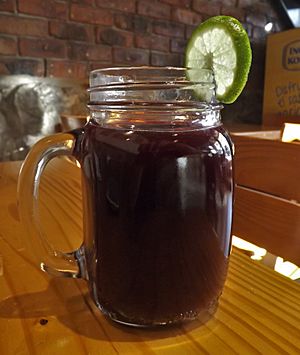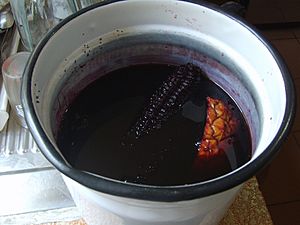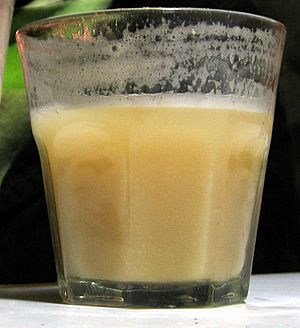Chicha facts for kids
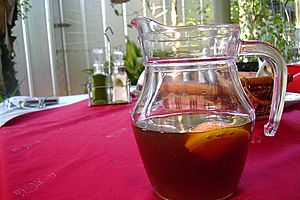
A jug of chicha morada served with pipeño, Olmué, Chile.
|
|
| Type | Beverage |
|---|---|
| Country of origin | Americas |
| Color | Purple |
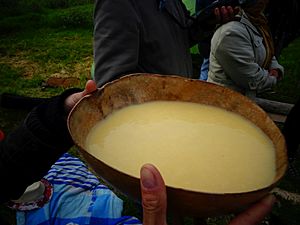
Chicha is a popular drink from Latin America. It comes from the Andes mountains and the Amazon rainforest areas. Chicha can be either fermented (meaning it has alcohol) or non-fermented.
For a very long time, the most common type of chicha has been made from different kinds of maize (corn). This corn-based drink is often called chicha de jora. However, chicha can also be made from many other plants. These include quinoa, kañiwa, peanut, manioc (also known as yuca or cassava), palm fruit, potato, oca, and chañar. There are many different ways to make chicha, depending on where you are. In the ancient Inca Empire, chicha was very important for ceremonies and special events.
Contents
What's in a Name?
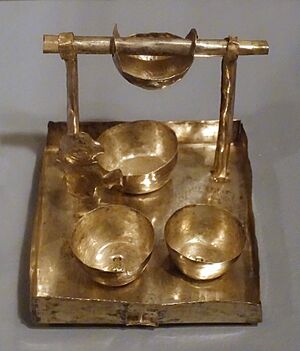
The exact origin of the word chicha is not fully known. Some people believe it came from the Taíno people. The Spanish then used it as a general word for any fermented drinks made by native groups in the Americas. It might have first been used by the Kuna people in Colombia and Panama.
However, some experts say chicha comes from the Kuna language word "chichab," which means maize. Others suggest it comes from the Nahuatl word "chichiatl," meaning "fermented water." The verb chicha means "to make a drink sour," and -atl means water. It's possible that all these ideas are partly true.
There's a Spanish saying, ni chicha ni limonada, which means "neither chicha nor lemonade." This phrase is used to describe something that is "neither one thing nor another," like saying "neither fish nor fowl" in English.
Corn Chicha
How is Corn Chicha Made?
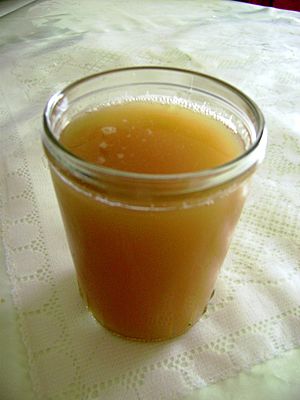
Chicha de jora is a corn beer made in a special way. First, the maize is allowed to sprout (germinate). This helps release natural sugars. Then, these sugars are extracted, and the liquid (called wort) is boiled. Finally, it's left to ferment in large pots, often made of clay, for several days.
Traditionally, people make chicha in big batches using many clay pots. The process is similar to making beer from barley. The type of corn used for chicha de jora often shows where it was made. Sometimes, quinoa or other ingredients are added to make it thicker. During boiling, the chicha is stirred to prevent it from boiling over. A hard form of sugar called Chancaca can help with the fermentation.
In some cultures, instead of sprouting the corn, the corn is ground up. Then, the chicha maker chews the corn and forms it into small balls. These balls are flattened and dried. The natural enzymes in the maker's saliva help break down the starch in the corn into sugars. This method of chewing grains to make alcoholic drinks was used in many ancient cultures, like for sake in Japan. Chicha made this way is called chicha de muko.
Chicha morada is a type of chicha that is not fermented, so it does not contain alcohol. It's usually made from purple corn ears (maíz morado). These are boiled with pineapple rind, cinnamon, and cloves. This creates a deep purple liquid, which is then mixed with sugar and lemon. This drink is a refreshing beverage, and purple corn has been found to have many health benefits. Chicha morada is very common in Bolivia and Peru and is often enjoyed with meals.
Women are often the main people who make chicha. While men and children might help, women usually control how it's made and sold. For many women in Andean societies, making and selling chicha is a big part of who they are. It can also give them social influence.
How is Chicha Used?
Chicha de jora has been made and enjoyed in the Andes for thousands of years. The Inca people used chicha for special ceremonies and drank a lot of it during religious festivals. Places where it was likely made have been found at Machu Picchu.
During the Inca Empire, women were taught how to brew chicha in special schools called Aqlla Wasi (feminine schools).
Chicherias are places where people go to drink chicha. Many of these have been small, home-based businesses that make chicha right there.
Chicha is often sold in large glasses or by the liter to take home. It's usually poured straight from the clay pot where it was brewed. In some parts of Peru, it's served in a dried gourd called a Poto. In the Peruvian Andes, it's often served in a qero. Qeros are special cups, traditionally made from wood with detailed carvings. In the past, Inca leaders used matching pairs of qeros to invite others to drink. This invitation helped build strong relationships and alliances between people and groups.
Different Kinds of Chicha
There are many regional types of chicha. They can be generally divided into those from the lowlands (Amazonia) and those from the highlands.
Amazonia
In the Amazon Rainforest, chicha is usually made from cassava (manioc), but sometimes from cooking plantains. Traditionally, women chew the peeled cassava and spit the juice into a bowl. Cassava root is very starchy, and the enzymes in saliva quickly turn the starch into simple sugar. This sugar then ferments into alcohol with natural yeast or bacteria. After a few hours, the result is a slightly sweet and sour chicha. In the Peruvian Amazon, this drink is called masato.
It's a tradition for families to offer chicha to guests. Children are given fresh chicha that hasn't fermented yet. Adults are offered fermented chicha, and the most fermented chicha, which has more alcohol, is saved for men.
Bolivia
In Bolivia, chicha is most often made from corn, especially in the highlands. However, amaranth chicha is also a traditional and popular choice. Chicha made from sweet manioc, plantain, or banana is common in the lowlands. Bolivian chicha often contains alcohol.
Chile
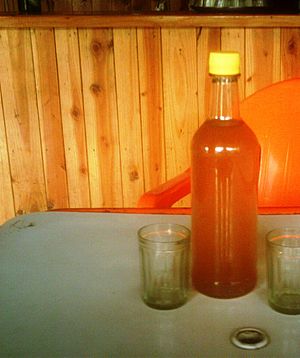
In Chile, there are two main kinds of chicha. Apple chicha is made in southern Chile, and grape chicha is made in central Chile. Both are alcoholic drinks that are fermented but not distilled. Chicha is mostly enjoyed in the countryside and during celebrations like Fiestas Patrias on September 18th. You usually won't find chicha in regular supermarkets unless it's close to September 18th.
Colombia
In Bogotá, the capital of Colombia, chicha is made from cooked maize and sugar, then fermented for about six to eight days.
Ecuador
A big chicha festival called Yamor takes place in early September in Otavalo. This festival started in the 1970s when local people decided to bring back an old tradition of celebrating the corn harvest before the September equinox. The local people spoke Quechua, and "Yamor" was their word for chicha. The festival includes music, parades, fireworks, and chicha tasting.
El Salvador
In El Salvador, chicha usually means an alcoholic drink made with maize, a type of sugar called panela, and pineapple. It's enjoyed as a drink and also used as an ingredient in many traditional dishes, like Gallo en Chicha, which is a local version of a chicken stew. A non-alcoholic version, often called fresco de chicha (chicha soft drink), is made with the same ingredients but without letting it ferment.
Honduras
In Honduras, the Pech people used to have a special ritual called Kesh. During this ritual, a shaman would connect with the spiritual world. A Kesh could be held for different reasons, like to calm angry spirits or to help someone who had passed away on their journey. During this ritual, they drank Chicha made from yucca, minia, and yucca tamales. The ritual is no longer practiced, but the drink is still saved for special family occasions.
Nicaragua
In Managua and Granada, "chicha de maiz" is a typical drink. It's usually not fermented and is served very cold. It's often flavored with banana or vanilla. You can hear vendors calling out "¡Chicha, cafe y jugo frio!" (Chicha, coffee, and cold juice!) in the town squares.
Nicaraguan "chicha de maiz" is made by soaking corn in water overnight. The next day, it's ground and placed in water, with red food coloring added. The mixture is then cooked. Once it cools, sugar and more water are added. The next day, more water, sugar, and flavoring are added. While fermented chicha is available, the non-fermented type is the most common.
Panama
In Panama, chicha can simply mean "fruit drink." Unfermented chicha is often called batido, which is another name for any drink with fruit puree. Among the Kuna people of the San Blas islands, "chicha fuerte" refers to the fermented corn and saliva mixture. This chicha is enjoyed on special or holy days. While "chicha fuerte" most often means chicha made from sprouted corn (which helps turn starch into sugar), many different fruits can be fermented to make unique, homemade versions of the drink. In rural areas, "chicha fuerte" is the drink of choice during and after community work parties, as well as during community dances.
Peru
Chicha was very important in the social and religious life of ancient Peru. Corn was considered a sacred crop, and chicha was seen as very special. Chicha was consumed in large amounts during and after harvest work, creating a joyful atmosphere with singing, dancing, and jokes. Chicha was offered to gods and ancestors, much like other fermented drinks around the world. For example, in the Inca capital of Cuzco, the king would pour chicha into a gold bowl at a special stone platform in the main plaza. The chicha would flow down this "gullet of the Sun God" to the Temple of the Sun, as amazed people watched.
Even today, Peruvians often sprinkle some chicha on the ground for "mother earth" from a shared cup before they drink. The cup then passes around according to each person's social status, with many toasts being offered.
Venezuela
In Venezuela, chicha or chicha de arroz is made from boiled rice, milk, and sugar. It's usually white and has a thick, creamy texture, like eggnog. It's typically served as a sweet, refreshing drink with ground cinnamon or condensed milk on top. This chicha de arroz has no alcohol because it's not fermented. Sometimes it's made with pasta or semolina instead of rice and is called chicha de pasta.
In most big cities, you can buy chicha from street vendors, known as Chicheros. These vendors usually use a flour-like mix and just add water. They often serve it with crushed ice and a straw, and you can ask for cinnamon, chocolate chips, or sweetened condensed milk on top. You can also find chicha sold in stores, just like milk and juices. In the Andean regions of Venezuela, like Mérida, there's another version called Chicha Andina. This one has fermented pineapple added, which gives it a more alcoholic taste. It's a typical Christmas drink.
Chicha's Importance in Inca Society
Identity and Community
How people use chicha can show how they see their own cultural identity. It also expresses ideas about gender, race, nationality, and community. Drinking chicha helps people build community and a shared identity, which keeps their social networks strong. It's often consumed during feasts and festivals, which are great times for strengthening social and cultural bonds. Making and drinking chicha helps organize society and can affect a person's social standing.
Rites of Passage
Chicha was used in special ceremonies for indigenous people like the Incas. It was very important in ceremonies for adolescent boys becoming adults, especially for the sons of Inca nobility. Young men would get their adult names in ceremonies that involved chicha. One activity these boys did was to go on a pilgrimage to mountains like Huanacauri, which had deep meaning. Boys did this about a month before a ceremony celebrating their coming of age. After the pilgrimage, the boys would chew maize to make the chicha they would drink at the end of the month-long ceremony. One activity involved running down a mountain to receive a kero of chicha from young women, which was meant to encourage them. Chicha played a big role in these ceremonies for young men.
Women Making Chicha
The role of women during the Inca period, before the Spanish arrived, also shows the importance of chicha. Women were vital to the Inca community. A special group of women, called the aclla or "Chosen Women," received formal training. These women were taken from their homes to the acllahuasi or "House of the Chosen Women." They dedicated their lives to the Inca religion, weaving, cooking, and chicha-brewing. Much of the chicha they made was used in ceremonies or when the community gathered to worship their gods. They started the chicha process by chewing maize to create a mushy texture that would then be fermented. The chicha made by the acllas was considered sacred because of the special women who produced it. This was a unique privilege, usually given only to the "most attractive women."
Inca Royalty and Chicha
The Incas themselves showed how important chicha was. The lords and royalty likely drank chicha from silver and gold cups called keros. Also, after defeating an enemy, Inca rulers would sometimes have the heads of defeated enemies turned into cups to drink chicha from. For example, Atahualpa reportedly drank chicha from an opposing foe's skull. This showed how powerful the Incas were after winning battles, and chicha was a key part of these celebrations.
When the Incas and the Spanish conquistadors met, the conquistadors did not understand how important chicha was. Titu Cusi, an Inca ruler, explained how his uncle, Atahualpa, reacted when the intruders disrespected chicha. Cusi said, "The Spaniard, upon receiving the drink in his hand, spilled it, which greatly angered my uncle." This story shows the deep connection the Incas had with chicha. If someone insulted this drink, they took it personally because it offended their beliefs and community.
Chicha in the Inca Economy
In the economy of the Incas, there was no money. Instead, the economy relied on trading products, exchanging services, and the Inca ruler giving out items to the people who worked for him. Chicha made by men along the coast was often traded or given to the Inca ruler. This was different from the women who made chicha inland, as they did so for community gatherings and other important ceremonies. Relationships were very important in the Inca community. Good relations with the Inca ruler could mean a family received extra goods that others didn't have. The Inca ruler would give chicha to families and to men who contributed to mit'a (a form of public service).
A steady supply of chicha was essential in the Incas' economy, just like other important daily goods. In the Andes fields, special care was taken when planting maize, and its location was chosen carefully. "Agricultural rituals connected the production of maize to the flow of power in society through chicha." The ability to plant maize showed an important social role someone had in their community. Because maize was so important, the state likely managed these farms. Drinking chicha together as a community was another key part of how the Incas lived daily. It was included in the meals the Incas ate.
Religious Importance
Making chicha was necessary for everyone because it was a sacred item to the people. This drink allowed people to remember the story of creation and the creator god Wiraqocha.
Images for kids
See also
 In Spanish: Chicha para niños
In Spanish: Chicha para niños


